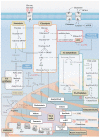Metabolic Plasticity of Acute Myeloid Leukemia
- PMID: 31370337
- PMCID: PMC6721808
- DOI: 10.3390/cells8080805
Metabolic Plasticity of Acute Myeloid Leukemia
Abstract
Acute myeloid leukemia (AML) is one of the most common and life-threatening leukemias. A highly diverse and flexible metabolism contributes to the aggressiveness of the disease that is still difficult to treat. By using different sources of nutrients for energy and biomass supply, AML cells gain metabolic plasticity and rapidly outcompete normal hematopoietic cells. This review aims to decipher the diverse metabolic strategies and the underlying oncogenic and environmental changes that sustain continuous growth, mediate redox homeostasis and induce drug resistance in AML. We revisit Warburg's hypothesis and illustrate the role of glucose as a provider of cellular building blocks rather than as a supplier of the tricarboxylic acid (TCA) cycle for energy production. We discuss how the diversity of fuels for the TCA cycle, including glutamine and fatty acids, contributes to the metabolic plasticity of the disease and highlight the roles of amino acids and lipids in AML metabolism. Furthermore, we point out the potential of the different metabolic effectors to be used as novel therapeutic targets.
Keywords: TCA cycle; acute myeloid leukemia; aerobic glycolysis; amino acids; drug resistance; fatty acids; leukemic stem cells; metabolic plasticity; oxidative phosphorylation; redox homeostasis.
Conflict of interest statement
The authors declare no conflict of interest.
Figures







Similar articles
-
Importance of glutamine metabolism in leukemia cells by energy production through TCA cycle and by redox homeostasis.Cancer Invest. 2014 Jul;32(6):241-7. doi: 10.3109/07357907.2014.907419. Epub 2014 Apr 24. Cancer Invest. 2014. PMID: 24762082
-
Cancer cell metabolism and mitochondria: Nutrient plasticity for TCA cycle fueling.Biochim Biophys Acta Rev Cancer. 2017 Aug;1868(1):7-15. doi: 10.1016/j.bbcan.2017.01.002. Epub 2017 Jan 18. Biochim Biophys Acta Rev Cancer. 2017. PMID: 28110019 Review.
-
Very long chain fatty acid metabolism is required in acute myeloid leukemia.Blood. 2021 Jun 24;137(25):3518-3532. doi: 10.1182/blood.2020008551. Blood. 2021. PMID: 33720355 Free PMC article.
-
Understanding and Targeting Metabolic Vulnerabilities in Acute Myeloid Leukemia: An Updated Comprehensive Review.Cancers (Basel). 2025 Apr 18;17(8):1355. doi: 10.3390/cancers17081355. Cancers (Basel). 2025. PMID: 40282531 Free PMC article. Review.
-
FBP1-Altered Carbohydrate Metabolism Reduces Leukemic Viability through Activating P53 and Modulating the Mitochondrial Quality Control System In Vitro.Int J Mol Sci. 2022 Sep 27;23(19):11387. doi: 10.3390/ijms231911387. Int J Mol Sci. 2022. PMID: 36232688 Free PMC article.
Cited by
-
Glutamine metabolism-related genes predict the prognostic risk of acute myeloid leukemia and stratify patients by subtype analysis.Hereditas. 2024 Sep 19;161(1):35. doi: 10.1186/s41065-024-00338-8. Hereditas. 2024. PMID: 39300580 Free PMC article.
-
Glucose Metabolism as a Potential Therapeutic Target in Cytarabine-Resistant Acute Myeloid Leukemia.Pharmaceutics. 2024 Mar 22;16(4):442. doi: 10.3390/pharmaceutics16040442. Pharmaceutics. 2024. PMID: 38675105 Free PMC article.
-
Narrative review of targetable features of pediatric acute myeloid leukemia from molecular and metabolic perspectives.Pediatr Med. 2021 Feb 28;4:9. doi: 10.21037/pm-20-98. Pediatr Med. 2021. PMID: 39877586 Free PMC article.
-
Role of metabolomic changes in diagnosis and assessment of treatment response in acute myeloid leukemia.Sci Rep. 2025 Aug 5;15(1):28576. doi: 10.1038/s41598-025-99845-5. Sci Rep. 2025. PMID: 40764381 Free PMC article.
-
The Interactome between Metabolism and Gene Mutations in Myeloid Malignancies.Int J Mol Sci. 2021 Mar 19;22(6):3135. doi: 10.3390/ijms22063135. Int J Mol Sci. 2021. PMID: 33808599 Free PMC article. Review.
References
-
- Arber D.A. Acute Myeloid Leukemia. In: Longo D.L., editor. Hematopathology: A Volume in the Series: Foundations in Diagnostic Pathology. Volume 12. Massachusetts Medical Society; Waltham, MA, USA: 2017. pp. 429–466.e5.
-
- Cancer Genome Atlas Research, Network. Ley T.J., Miller C., Ding L., Raphael B.J., Mungall A.J., Robertson A.G., Hoadley K., Triche T.J., Laird P.W., et al. Genomic and epigenomic landscapes of adult de novo acute myeloid leukemia. N. Engl. J. Med. 2013;368:2059–2074. doi: 10.1056/nejmoa1301689. - DOI - PMC - PubMed
Publication types
MeSH terms
LinkOut - more resources
Full Text Sources
Medical

